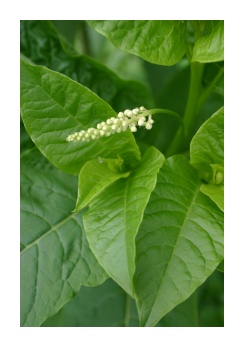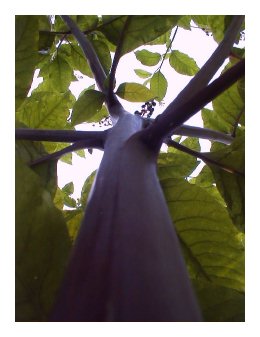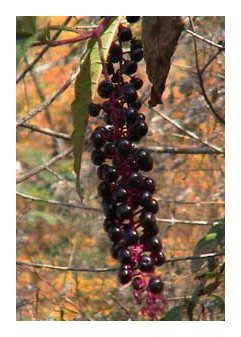Poke-ing around in the garden
by Corinna Wood
Editor’s note: Pokeweed is a potentially toxic
plant; taken in large doses, it can cause severe side effects,
including nausea, vomiting and diarrhea. Try these recipes
at your own risk.
Growing up in the Northeast, I loved playing with the
purple pokeberries, painting designs on my skin. My parents
allowed this, though they made it clear that I shouldn’t
eat the berries of this “poisonous, invasive weed.”
The huge poke plants were such a bane in their garden that
they would actually tie a rope around the roots and use
a Jeep to pull them out!
So when I moved to the South, I was surprised to hear
a number of people report that their grandmothers always
ate poke as a spring green. Intrigued, I discovered that
poke root has traditionally been used in tiny doses as an
immune stimulant. And swallowing one berry a day is an old
treatment for arthritis. This powerful plant actually has
a wide range of medicinal uses -- but you have to treat
it with respect or risk unpleasant side effects (see below).
 As
it turns out, there’s a long history here in the mountains
of using this common “weed” as a potherb. But
don’t make the all-too-common mistake of confusing
“poke sallit” (the English word for cooked greens)
with “poke salad.” DON’T EAT POKE IN A
SALAD! It’s considered safe ONLY when boiled in three
changes of water (traditionally with some pork or “fatback”).
And it should be harvested for cooking greens ONLY when
the plant is less than a foot tall.
As
it turns out, there’s a long history here in the mountains
of using this common “weed” as a potherb. But
don’t make the all-too-common mistake of confusing
“poke sallit” (the English word for cooked greens)
with “poke salad.” DON’T EAT POKE IN A
SALAD! It’s considered safe ONLY when boiled in three
changes of water (traditionally with some pork or “fatback”).
And it should be harvested for cooking greens ONLY when
the plant is less than a foot tall.
I’ve cooked poke this way a few times. It was certainly
tasty (especially with the fatback!), but I was still a
bit mystified. Why all the focus on poke? This is a time
of year when many wild greens are abundant -- dandelion,
chickweed and nettles are among my favorites. And with these,
you don’t need to toss out the cooking water (and
a lot of nutrients with it). But I do know folks who say
they feel a powerful energy from eating the poke greens.
My favorite way to use poke is to make a tincture from
the root for stimulating the immune system. Herbs can rival
the effectiveness of antibiotics, and they’re generally
much gentler on the body. Many herbalists turn to goldenseal
for this purpose, but it’s an endangered species.
Poke, on the other hand, is a weed -- the problem is not
having too little of it, but too much. And for most purposes,
poke is at least as good, if not better.
Pokeroot is best dug up in the fall, after the plant has
died back for the winter. This is when the plant is the
most medicinal and the least toxic. The next best time to
dig the roots is in the early spring, when the leaves are
just coming out (as long as you’re sure what you’re
picking!).
As anyone who’s ever tried to pull up a poke plant
knows, getting anything but the smallest roots out of the
ground is a project. They range in size from a large carrot
to a construction cone. Fortunately, just one small root
will make enough medicine to last you and your loved ones
for years -- proving once again that there’s no lack
of good medicine all around us.
 Once
you’ve dug up the root (and parked the Jeep), the
next step -- if you’ve decided to give pokeweed a
try -- is drawing out those medicinal properties. The best
way to do that is to make a tincture (alcohol extract).
Wash the root, chop it into small pieces, fill a jar with
the plant material, and then add enough 100-proof alcohol
to cover the roots. Leave it on your counter for six weeks,
then strain out the roots. The resulting milky liquid is
remarkably mild-looking and -tasting, considering the punch
it packs.
Once
you’ve dug up the root (and parked the Jeep), the
next step -- if you’ve decided to give pokeweed a
try -- is drawing out those medicinal properties. The best
way to do that is to make a tincture (alcohol extract).
Wash the root, chop it into small pieces, fill a jar with
the plant material, and then add enough 100-proof alcohol
to cover the roots. Leave it on your counter for six weeks,
then strain out the roots. The resulting milky liquid is
remarkably mild-looking and -tasting, considering the punch
it packs.
Poke is so powerful that it’s taken by the drop.
Begin with one to three drops (using a dropper, of course).
Wait 24 hours. If that doesn’t seem to help, add one
drop per day to the dosage (and that’s drops, not
droppersful!).
Individuals show widely varying tolerance for poke. Some
people can’t handle more than three or five drops
per day, while others can take 25 or 50 drops with no adverse
effects. The side effects of poke include mental unclarity,
spaciness and out-of-body feelings. If you notice such feelings,
it means you've found your tolerance level, so back off
to a lower dosage. If you take way too much (such as mistaking
droppersful for drops, which some people have done!), you
may encounter more severe side effects, such as nausea,
vomiting and diarrhea.
When I was using poke to treat Lyme disease a number of
years ago, I found that after taking 10 drops per day for
several weeks, I started feeling unclear, spacy and disconnected,
as if I weren’t really in my body. I cut the dosage
back to five drops and the side effects vanished, but the
tincture was still very effective in helping resolve the
Lyme disease. Remember, everyone’s tolerance and needs
are different.
Over the years, I’ve found poke to be invaluable
as an herbal alternative to antibiotics when immune or lymphatic
stimulation is needed. For many generations, this plant
has helped people with immune issues ranging from sore throat
to breast cancer. And of course, there are times when antibiotics
are called for -- so when in doubt, consult your doctor
or herbalist.
In my community, poke tincture is a favorite for sore
throats, strep throat, severe colds and respiratory infections.
It’s also used for infected gums, swollen lymph glands
and breast cysts. Studies in Germany and the United States
are even finding positive results with HIV, cancer and lymphoma.
In addition, it’s very effective in treating genital
herpes -- taking just a few drops when the tingling begins
usually prevents the blister phase entirely and reduces
the frequency of outbreaks.
 Poke
root can also be made into an oil simply by substituting
oil for alcohol. Any cooking oil will work, but olive oil
is my favorite because of its high resistance to rancidity.
And by melting in some beeswax (which gives it a creamy
consistency), the oil can be made into a balm or salve.
Both the salve and the oil are also used externally to dissolve
lumps, bumps, growths and tumors. And many people find them
helpful when applied externally to swollen lymph glands,
sore throats or breast lumps.
Poke
root can also be made into an oil simply by substituting
oil for alcohol. Any cooking oil will work, but olive oil
is my favorite because of its high resistance to rancidity.
And by melting in some beeswax (which gives it a creamy
consistency), the oil can be made into a balm or salve.
Both the salve and the oil are also used externally to dissolve
lumps, bumps, growths and tumors. And many people find them
helpful when applied externally to swollen lymph glands,
sore throats or breast lumps.
Pokeberries are useful, too -- and not just for body paint.
(This paint, by the way, is quite safe; it’s only
the seeds inside that are toxic, and then only when chewed.)
In Appalachian folk medicine, the berries are swallowed
as a treatment for arthritis and for immune stimulation
-- one berry (either fresh or dried) is the equivalent of
one drop of root tincture.
Since the seeds are the toxic part, you just spit them
out. And even if you swallow some seeds, don’t worry
-- they’re extremely difficult to break open with
your teeth and will come out the other end intact. (That’s
how poke spreads, in fact -- birds love to eat the berries,
and then the seeds spread through their droppings.) Although
poke proliferates by seed, the plants are perennial, and
the roots will grow larger every year.
So if you find yourself cursing this “dangerous,
noxious weed” in your yard or garden this spring,
just remember that if you let a few plants thrive until
fall, they can reward you with some very powerful medicine
-- not to mention beautiful purple berries that make a delightful
body paint!
Corinna Wood, the director of Red Moon Herbs, has been
teaching herbal medicine for more than 10 years. She can
be reached at 669-1310 or via her Web site (redmoonherbs.com).




 Study
with Susun Weed in the convenience of your home! Choose from
four Correspondence Courses: Green Allies, Spirit & Practice
of the Wise Woman Tradition, Green Witch, and
Study
with Susun Weed in the convenience of your home! Choose from
four Correspondence Courses: Green Allies, Spirit & Practice
of the Wise Woman Tradition, Green Witch, and 
